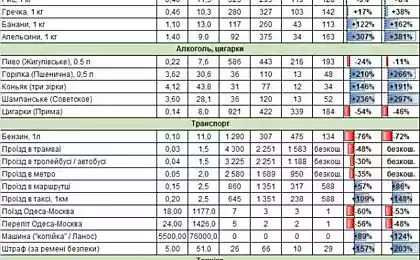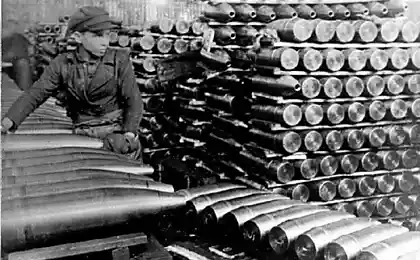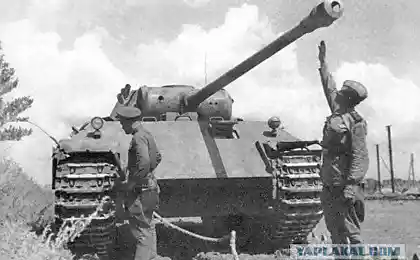2226
Ten Soviet machines
On Thursday, January 16 marks exactly 55 years since, as the assembly line of Gorky Automobile Plant went the first instance of a luxury sedan GAZ-13 "Chaika". One of the most beautiful cars in the history of the Soviet Union gave us a good excuse to recall a few production cars of the Soviet Union, for which no need to blush, neither then nor now
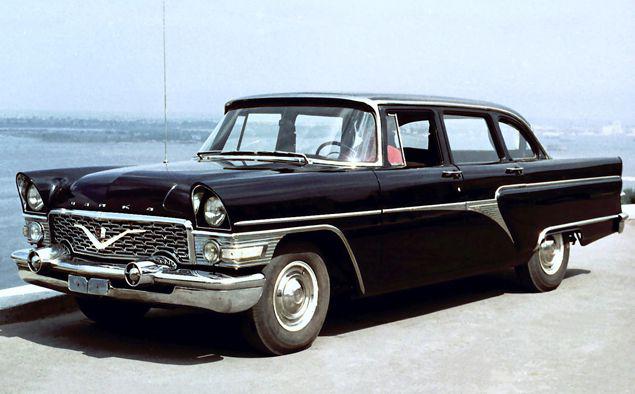
ZIS-5
~ 1933-1958 ~
Put famous "Zahara" next to the American truck Autocar Dispatch SA, and climbs to the head immediately familiar: "And it licked." Lick, of course, but ... not quite. Firstly, the US car sets, which started the truck, were delivered to the USSR quite legally. And most importantly, the engineers who created the ZIS-5, were able to significantly reduce the cost and simplify the transatlantic structure without significant loss of consumer qualities. It is this and played a decisive role in the fate of the heroic "trehtonki».
During the Great Patriotic War, the ZIS-5 have looked outdated, but the simplicity and reliability of the truck made him a figure almost epic scale. For reliability in the most brutal exploitation of the ZIS-5 was loved by all. Even the Germans, who are used to the truck, "Opel" and "Mercedes", willingly used captured "Zahara" sincere admiration unpretentious Russian art.
So ZIS-5 was before the war: two lights, beautiful bent wings, brakes on all wheels

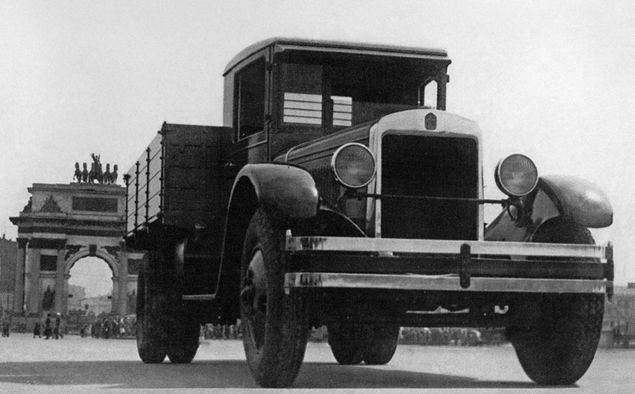
However, during the war and immediately after gasoline was in short supply, so ZISe as in other plants, fired gasifier version of its machine. Fuel is common logs, which in Russia has always been in abundance
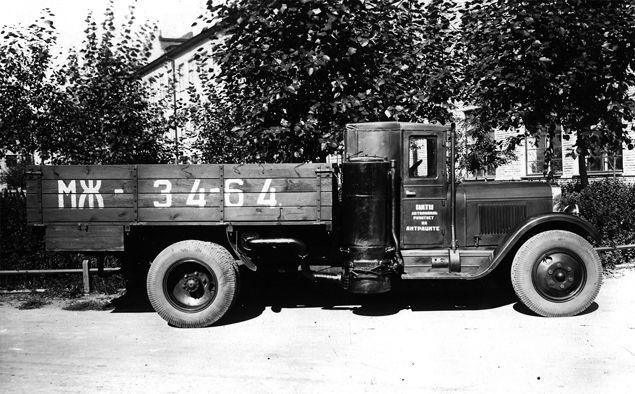
The needs of wartime led to a simplified modification of the ZIS-5B with a wooden cabin, a lamp, brakes only on the rear wheels and angular wings
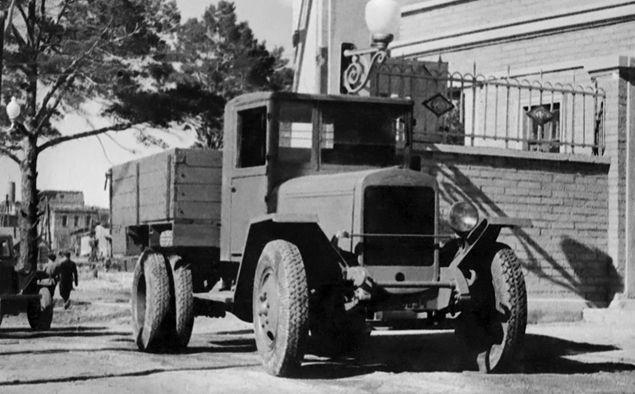
GAZ-M20 "Victory»
~ 1946-1958 ~
The first post-war passenger car of the USSR and is arguably one of the most famous. Development of the "Victory" began in 1943, when the victory was long before the two years. It was a really advanced the development of one of the world's first pontoon (that is integrated in the sidewall wings) body, the actual carrier power structure. Not to mention strange for the Soviet machine indicator, steklochistitelyah electric and radio in the cabin.
Introduced in 1946, the GAZ-M20 - a modern, beautiful and best - has become a symbol of the Soviet triumph in the bloodiest of wars. And although the quality of the first instances of lame (for which, incidentally, is the chief designer of the car Lipgart Andrew received a reprimand from the top), "Victory" will forever remain in people's memory the legendary car.
GAZ M20 - a rare Soviet car that does not follow the trend, and he asked them
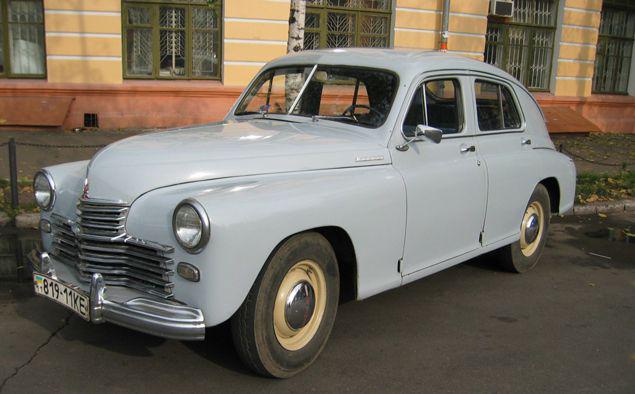

Convertible sedan based on the "Victory" - a symbol of the country's shortage of steel, not beautiful life
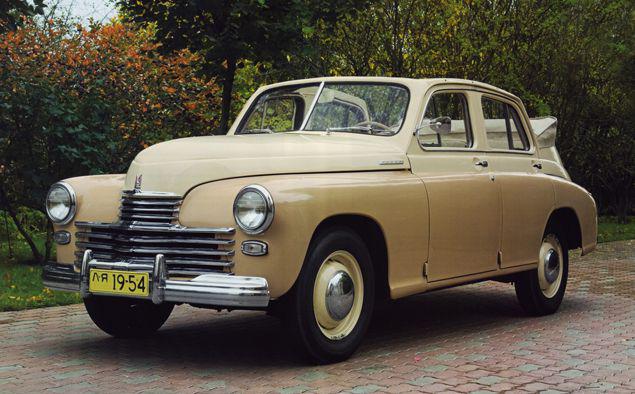
Four-wheel drive GAZ M72 was the result of crossing a body "Victory" and GAZ-69 units. Total from 1955 to 1958 were produced 4677 cars
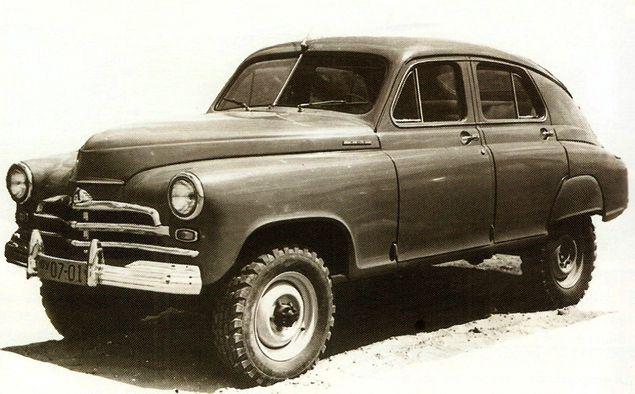
GAZ-12 ZIM
~ 1950-1960 ~
Even hitting a disgrace, Andrew Lipgart continued to work and became the godfather of one more sign of the Soviet machine. ZIM is unique even by the fact that the world's first six-seater car with three rows of seats and the supporting structure of the body. It may sound as loud as "won first place in its class," but, nevertheless, does not detract from the merits of the machine.
Sedan long five and a half meters turned out successful in all respects. In winter was a solid appearance (interspersed with a clear "kadillakovskih" motifs), a fairly high level of comfort (oven with a supply of air to the rear seats, tri-band radio and enviable smooth progress), as well as ... unexpected closeness to the people. The fact that GAZ-12 became the first and, as it later turns out, the only Soviet luxury car, which was offered for sale to private hands. However, ZIM was worth almost three times more expensive, "Victory", but it is, as they say, is another question.
ZIM lost frame is not due to a desire gorkovchan be ahead of the rest. Just to "gas" was not sufficiently powerful motor, and refusal to allow the frame to reduce the weight of the vehicle
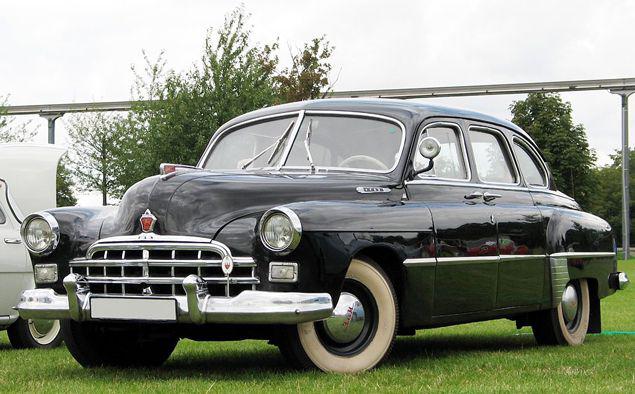
Disclaimer frame led to the fact that the body desperately lacked rigidity. Therefore, by the way, the convertible version of the project remained
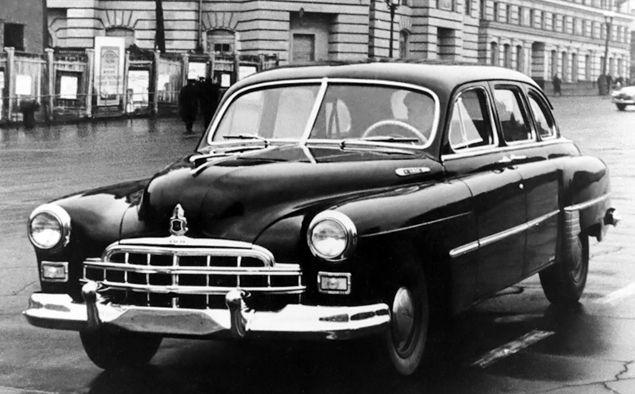
Let not been formally ZIM limousine (the partition between the driver and the passenger was missing), but the space in the back seat was the most that neither is "limuzinovskim»
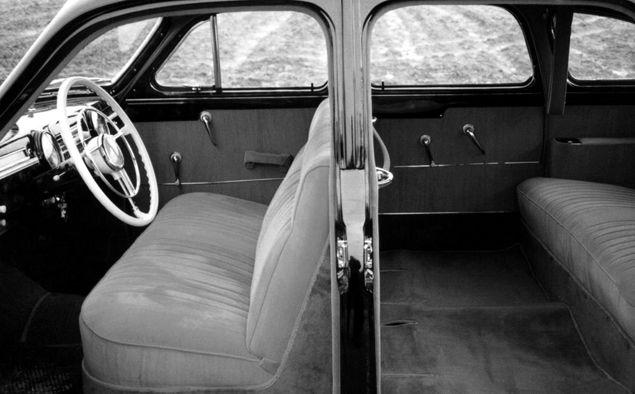
Before the advent of RAF minibus was GAZ-12 played the role of taxis ...
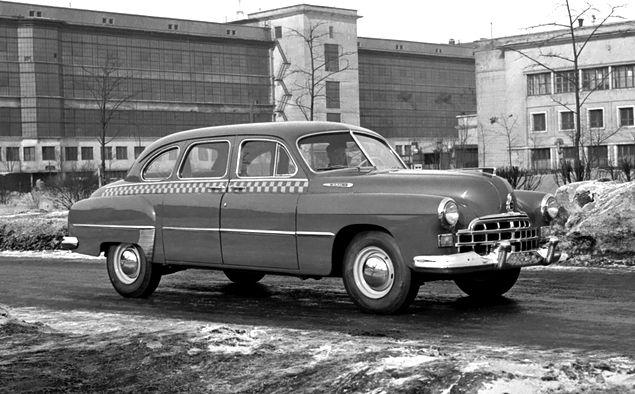
... And ambulances. With the advent of the "Volga" GAZ-22 versatile person executive cars in the USSR ceased to perform such exotic for their function
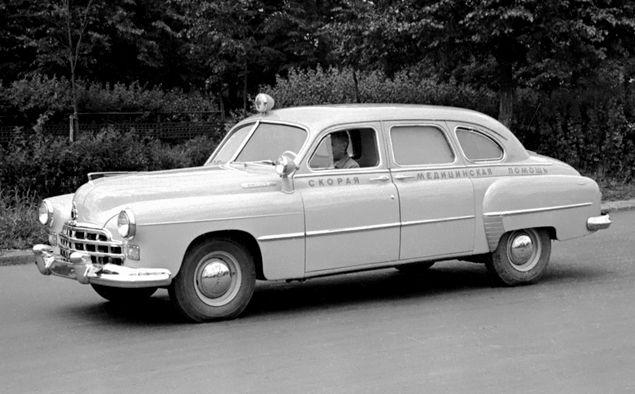
GAZ-69
~ 1951-1972 ~
If the predecessor "goat" - Army GAZ-67 - can still be possible to consider the development of design "lendlizovskogo» Willys MA / MB, the 69 th - is another matter.
The development of lung hardy SUV tentatively, but very scenic designation "Laborer" began immediately after the war. Structurally, the machine was more traditional - a powerful spar frame, girder bridges in a circle, the geometric characteristics of the great cross. In the valleys, and in the mud, "sixty-nine" went no worse than the vaunted "Land-Rover" and "jeeps". More importantly, the "goat", more than half generated from other components and assemblies, "lawn", came easy to maintain and phenomenally maintainable. In addition, at the time of GAZ-69 was active in the export.
"Goat" in the version with three different doors side-spare wheel, which is why the driver's door was also a passenger

The three-door body GAZ-69 was placed artillery calculation, and the SUV can tow pushku- "sorokopyatki»

The five-door version has identical doors, rear-mounted "spare wheel" and an elegant silhouette
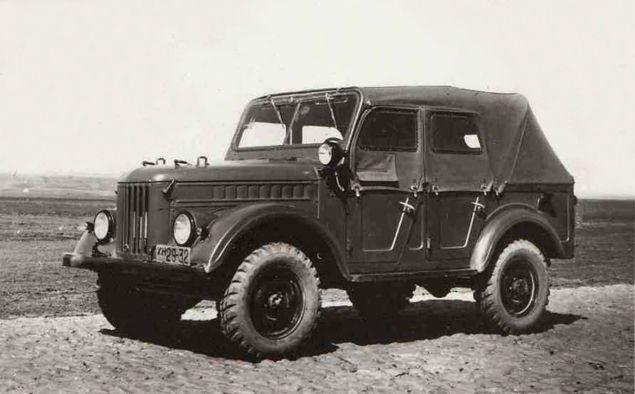
GAZ-21 "Volga»
~ 1956-1970 ~
With this machine simple. Do not love "Volzhanka" absolutely impossible, although no sensation in the automotive world, it did not. In fact, a thoroughly "Victory", "Volga" even for its time, was a set of standard technical solutions. The main innovation of the 21 th was supposed to be automatic transmission, which at GAZ planned to equip all the machines, but the idea has broken the firm Soviet realities. Good oil "machines" in the USSR could not be found, and experts in their repair was not even more so.
But on the charisma of the "Volga", painted by Leo Eremeev, tucked in his belt and Ford Mainline, which it looked like his now immortal contours, and, of course, all domestic passenger cars era. That there is only a figure of a deer on the hood!
Bulletproof Suspension, excellent permeability, a huge trunk, a spacious interior. Dream, not a machine!
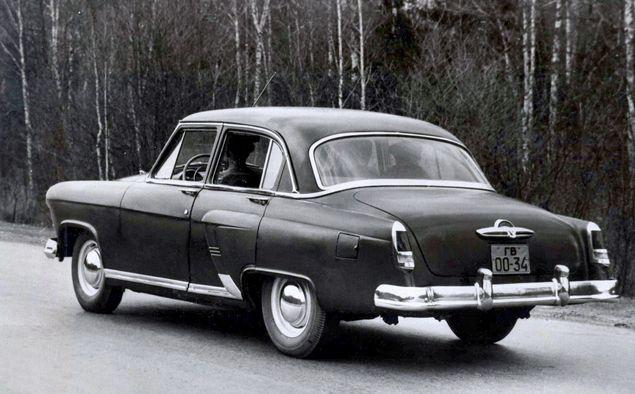
The second series, she is the "shark mouth". It seemed so original prototype of the "Volga", the rejected Marshal Georgy Zhukov on gospriemka. The car was on the line from 1959 to 1962. Total circulation - 140,000 sedans
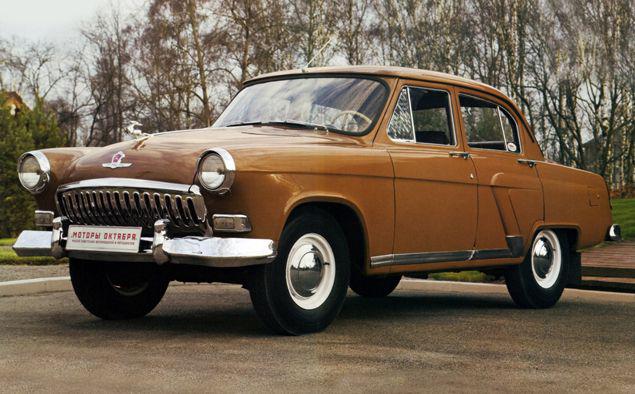
GAZ-21 of the third series was produced from 1962 to 1970. In all there were more than 470 000 vehicles, was nicknamed "whalebone" for a plurality of vertical slots in the grille. Alas, this car was no deer on the hood
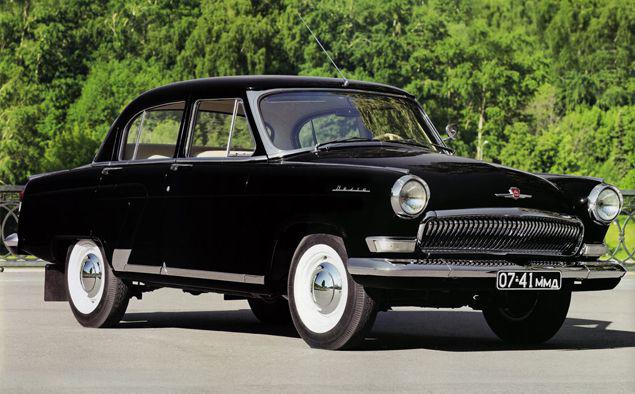
Wagon GAZ-22 is available for sale have been reported. Soviet motorists could only hope to be deducted from the purchase of a used car business
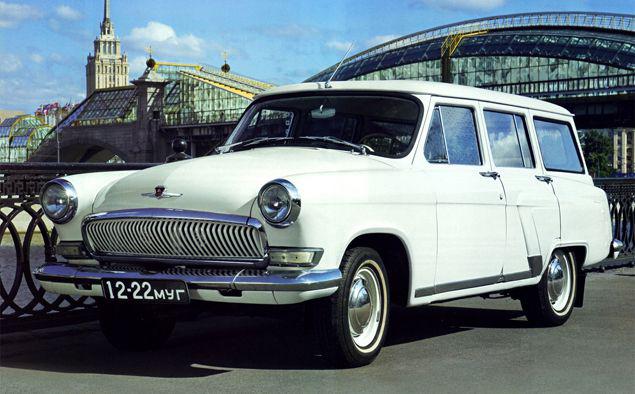
GAZ-13 "Chaika»
~ 1959-1981 ~
Beauty - terrible force. Even the beauty of this with a strong American accent. It is foolish to deny that a muse for designers "The Seagull" (among them was the creator of the "Volga" GAZ-21 Leo Eremeev) began overseas counterparts. Or rather, a very specific one analogue - an incredibly elegant, but it is terribly unfortunate Packard Caribbean / Patrician. The machine, which has become final in the history of the famous American company, without significant changes migrated to Kuhlman gazovskih engineers, after which became a legend in the Soviet Union.
Americanism is permeated not only the appearance of "The Seagull." Instead of a progressive "Zimouski" the supporting structure of GAZ-13 has received a frame and inline six under the hood replaced the 5, 5-liter 195-horsepower V8 from ... armored personnel carrier BRDM-2. Plus, of course, automatic, plush seats, power steering and even electric.
Belle "Seagull" was not offered for sale to mere mortals. GAZ-13 became the exclusive transport of Soviet officials of different caliber. But ordinary citizens, seeing the cortege of black "Gull," could with pride for the country to think: "Oh, because we can, if we want!».
Powerful V8 allowed with a clear conscience to apply the frame, making the "Seagull" much more durable than the GAZ-12
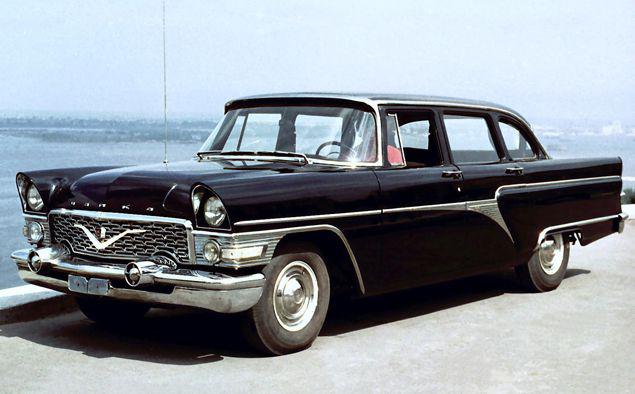
"Black Doctor" - a unique wagon followed the limousine elderly members of the Politburo with a team of intensive care. What are the leaders, so is a tuple!
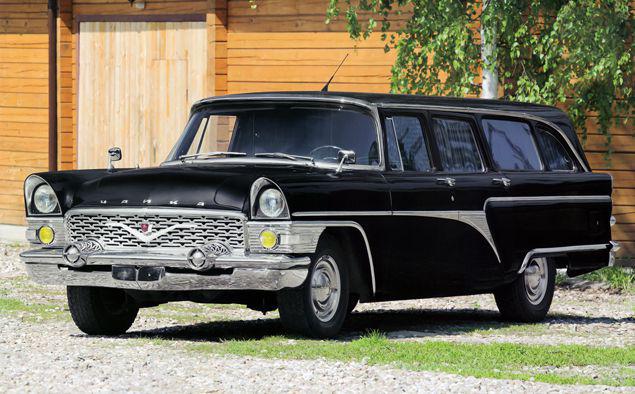
The distinguishing feature of "The Seagull" - push-button control automatic transmission, as well as on American cars of those years
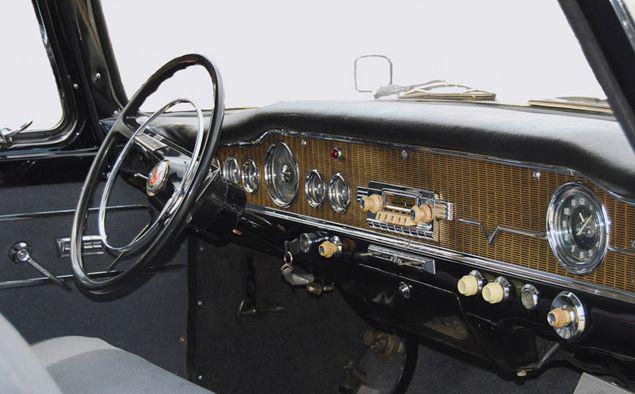
Moskvitch 408
~ 1964-1975 ~
The car marked the brief golden age of AZLK. The history of "Muscovites", which began with conventionally-licensed versions of "Opel Cadet", continued the more modern, but similar to the Ford Anglia model 403. And only then to the top of the production chain perched sophisticated, modern, and no one in general, not "lapped up" 408 minutes.
The release of this sweet sedan was launched in September 1964. Just look at the contemporary European classmates "Moskvich" to immediately penetrate into the car respect and sympathy. Joking aside, Opel Kadett A, Volkswagen typ 3 or Renault 8 on the background of the Soviet car looked rather pale. And it is 408 minutes paved the path to a Soviet passenger car markets are not only Eastern but also in Western Europe.
This model, as established on the basis of its 412th successfully sold in France, Belgium, the UK and the Nordic countries. In the best years abroad swam over 50 per cent of all issued on AZLK cars! It is a pity that the whole subsequent history of the plant at the Volgograd Prospekt in Moscow - just rushing downhill.
Over the years, the production of 408/412 tried a lot of different radiator grilles and headlamps options. Here is perhaps one of the most classic versions

The woman behind the wheel? Management of 408-m no brainer!
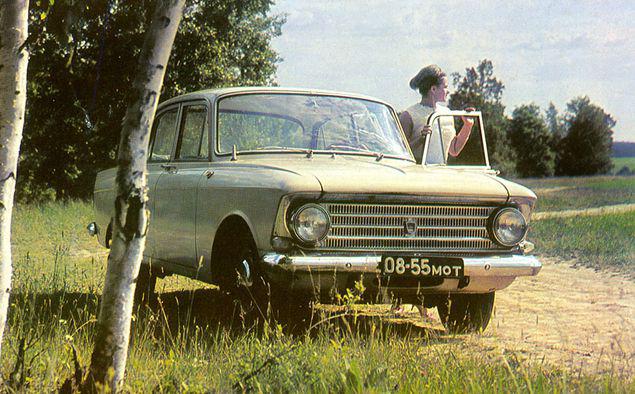
Beautiful, but so close. "Muscovites" third generation has been criticized for a high trunk floor and tightness in the back couch. However, the popularity of this did not prevent
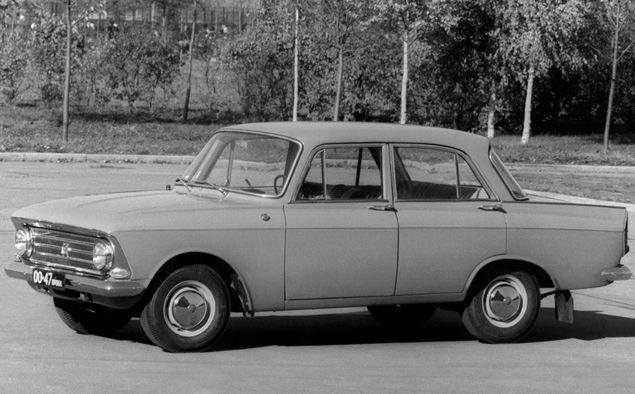
BelAZ-540
~ 1967 - currently ~
At this point, in principle, could be any rigid dumper Belarusian Automobile Plant. Multi-ton giants are dazzling, even in photographs, and even live to see such a giant - and at unforgettable.
For half a century the glorious company of the biography of the Belarusian town of Zhodino has issued more than 150 thousand trucks monsters - far more than the US Caterpillar, another authority in the field of large-size samosvalostroeniya.
"BelAZ" dismantled prestigious prizes at international specialized exhibitions in the Soviet times, and today the plant in Zhodino, is one of the main earners of foreign currency for Belarus, releasing a dozen models of the capacity from 30 to 450 tons.
Manufacturing of dump trucks in Zhodino began in 1958. Prior to that, such machines produced MAZ
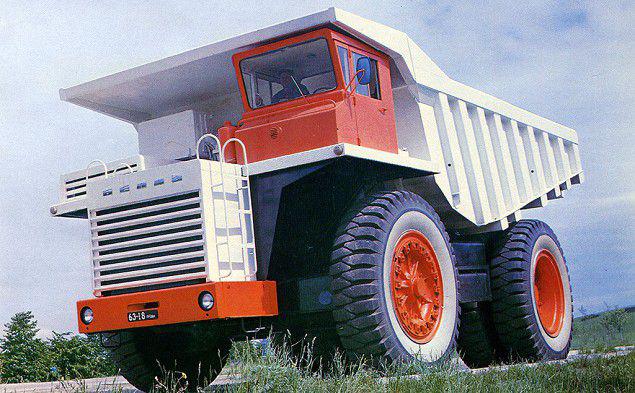
27-ton BelAZ-540 became the first independent model of the plant. Production began in 1961

In the history of the plant it was built 140,000 vehicles. Belaz - the largest manufacturer of dump trucks in the world!
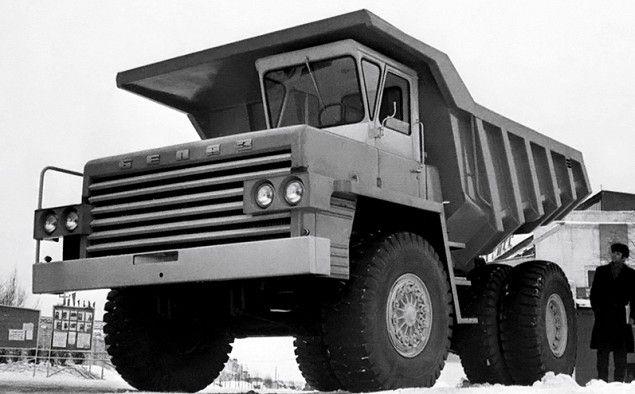
VAZ-2121
~ 1977 - currently ~
Many patriots from among indifferent to cars sure - a genre-terrain cars (or, more simply, comfortable SUV) was invented in the USSR. The argument often cited GAZ-72 - batten down the "Victory" with drive 4x4, which inevitably gives rise to heated debates.
Leaving them aside, we note that the world's first compact all-terrain vehicle has a comfortable honor considered the VAZ-2121 "Niva". By combining in a single form factor of a passenger handling and comfort, excellent permeability, permanent four-wheel drive and the support structure of the body, "Niva" is still in the 1970s showed what would be the SUVs next 20-30 years.
I would not like to arrange hits on the charts, but maybe that VAZ-2121 rightly regarded as the most successful car in the history of the Soviet. And the years, not the power of the machine, it only confirms.
Since its inception, "Niva" was one of the most popular cars on the domestic export markets
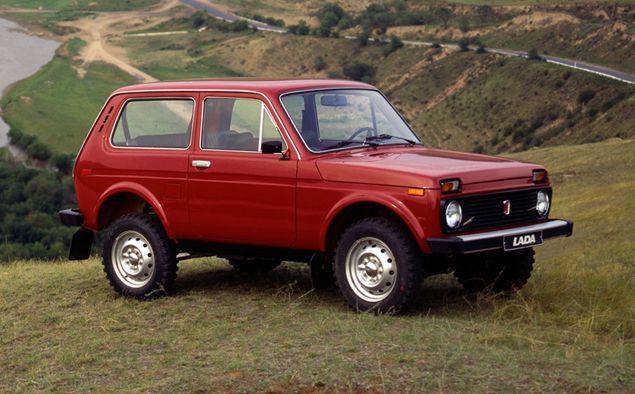
Despite the fact that the management of "Niva" requires uncommon strength, the car enjoyed steady demand from women, because it gave real freedom of movement

Most of the boot loading height reduced during renovation in the mid 90s. Alas, by the time the construction itself "Niva" is hopelessly outdated
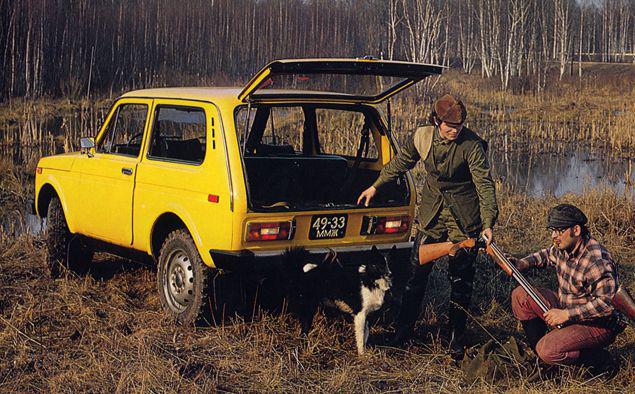
"Field" - one of the few Soviet cars sold in Japan

VAZ-2108
~ 1984-2003 ~
Another car VAZ shame that can only be for one reason only: on the assembly line, "chisel" in all its versions staid already thirty years! Too much even for the cult car: assembly "Samar" stopped only in late 2013.
In general, the original "eight" - a breakthrough for its time. The first domestic front-wheel machine for early 1980 - it is a challenge to public foundations. Bold aggressive design, unconventional for the USSR two-volume hatchback body type, and most importantly - high engineering samples. The fact that the creation of the car was attended by experts Porsche - not a beautiful tale of the marketing department. The museum storerooms German company has one of the first serial "eights" (beige color scheme, brown Salon) as a sign of belonging to the birth of the Russian "Sputnik", which became then "Samara».
Since 1984, the "AvtoVAZ" has managed to sell more than 5, 2 million copies of "Samara". Of these, 70 percent were in the first generation machines. "Samara" sold not only in Russia but also in export markets. And in the nineties, a special version of the assembly even pyatidverki established in Finland in the factory Valmet.
The three-door body, front-wheel drive, powerful engine, - "eight" seemed a real sports car
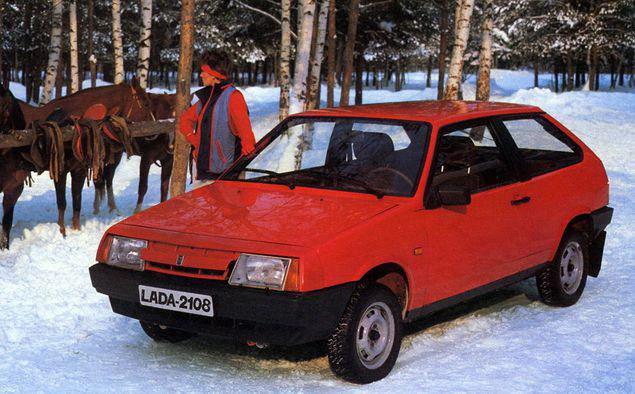
From Porsche at the VAZ-2108 is not only the aerodynamics, and door handles. Exactly the same installed, for example, model 924

The so-called "short wing" thing of the past in 1991, depriving the "Samara" one of the distinguishing features of
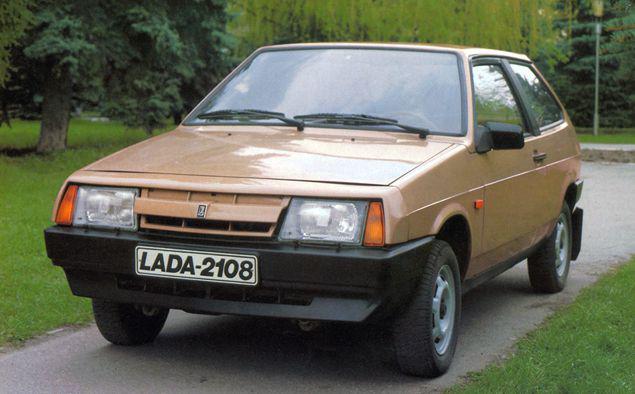
Source: motor.ru

ZIS-5
~ 1933-1958 ~
Put famous "Zahara" next to the American truck Autocar Dispatch SA, and climbs to the head immediately familiar: "And it licked." Lick, of course, but ... not quite. Firstly, the US car sets, which started the truck, were delivered to the USSR quite legally. And most importantly, the engineers who created the ZIS-5, were able to significantly reduce the cost and simplify the transatlantic structure without significant loss of consumer qualities. It is this and played a decisive role in the fate of the heroic "trehtonki».
During the Great Patriotic War, the ZIS-5 have looked outdated, but the simplicity and reliability of the truck made him a figure almost epic scale. For reliability in the most brutal exploitation of the ZIS-5 was loved by all. Even the Germans, who are used to the truck, "Opel" and "Mercedes", willingly used captured "Zahara" sincere admiration unpretentious Russian art.
So ZIS-5 was before the war: two lights, beautiful bent wings, brakes on all wheels


However, during the war and immediately after gasoline was in short supply, so ZISe as in other plants, fired gasifier version of its machine. Fuel is common logs, which in Russia has always been in abundance

The needs of wartime led to a simplified modification of the ZIS-5B with a wooden cabin, a lamp, brakes only on the rear wheels and angular wings

GAZ-M20 "Victory»
~ 1946-1958 ~
The first post-war passenger car of the USSR and is arguably one of the most famous. Development of the "Victory" began in 1943, when the victory was long before the two years. It was a really advanced the development of one of the world's first pontoon (that is integrated in the sidewall wings) body, the actual carrier power structure. Not to mention strange for the Soviet machine indicator, steklochistitelyah electric and radio in the cabin.
Introduced in 1946, the GAZ-M20 - a modern, beautiful and best - has become a symbol of the Soviet triumph in the bloodiest of wars. And although the quality of the first instances of lame (for which, incidentally, is the chief designer of the car Lipgart Andrew received a reprimand from the top), "Victory" will forever remain in people's memory the legendary car.
GAZ M20 - a rare Soviet car that does not follow the trend, and he asked them


Convertible sedan based on the "Victory" - a symbol of the country's shortage of steel, not beautiful life

Four-wheel drive GAZ M72 was the result of crossing a body "Victory" and GAZ-69 units. Total from 1955 to 1958 were produced 4677 cars

GAZ-12 ZIM
~ 1950-1960 ~
Even hitting a disgrace, Andrew Lipgart continued to work and became the godfather of one more sign of the Soviet machine. ZIM is unique even by the fact that the world's first six-seater car with three rows of seats and the supporting structure of the body. It may sound as loud as "won first place in its class," but, nevertheless, does not detract from the merits of the machine.
Sedan long five and a half meters turned out successful in all respects. In winter was a solid appearance (interspersed with a clear "kadillakovskih" motifs), a fairly high level of comfort (oven with a supply of air to the rear seats, tri-band radio and enviable smooth progress), as well as ... unexpected closeness to the people. The fact that GAZ-12 became the first and, as it later turns out, the only Soviet luxury car, which was offered for sale to private hands. However, ZIM was worth almost three times more expensive, "Victory", but it is, as they say, is another question.
ZIM lost frame is not due to a desire gorkovchan be ahead of the rest. Just to "gas" was not sufficiently powerful motor, and refusal to allow the frame to reduce the weight of the vehicle

Disclaimer frame led to the fact that the body desperately lacked rigidity. Therefore, by the way, the convertible version of the project remained

Let not been formally ZIM limousine (the partition between the driver and the passenger was missing), but the space in the back seat was the most that neither is "limuzinovskim»

Before the advent of RAF minibus was GAZ-12 played the role of taxis ...

... And ambulances. With the advent of the "Volga" GAZ-22 versatile person executive cars in the USSR ceased to perform such exotic for their function

GAZ-69
~ 1951-1972 ~
If the predecessor "goat" - Army GAZ-67 - can still be possible to consider the development of design "lendlizovskogo» Willys MA / MB, the 69 th - is another matter.
The development of lung hardy SUV tentatively, but very scenic designation "Laborer" began immediately after the war. Structurally, the machine was more traditional - a powerful spar frame, girder bridges in a circle, the geometric characteristics of the great cross. In the valleys, and in the mud, "sixty-nine" went no worse than the vaunted "Land-Rover" and "jeeps". More importantly, the "goat", more than half generated from other components and assemblies, "lawn", came easy to maintain and phenomenally maintainable. In addition, at the time of GAZ-69 was active in the export.
"Goat" in the version with three different doors side-spare wheel, which is why the driver's door was also a passenger

The three-door body GAZ-69 was placed artillery calculation, and the SUV can tow pushku- "sorokopyatki»

The five-door version has identical doors, rear-mounted "spare wheel" and an elegant silhouette

GAZ-21 "Volga»
~ 1956-1970 ~
With this machine simple. Do not love "Volzhanka" absolutely impossible, although no sensation in the automotive world, it did not. In fact, a thoroughly "Victory", "Volga" even for its time, was a set of standard technical solutions. The main innovation of the 21 th was supposed to be automatic transmission, which at GAZ planned to equip all the machines, but the idea has broken the firm Soviet realities. Good oil "machines" in the USSR could not be found, and experts in their repair was not even more so.
But on the charisma of the "Volga", painted by Leo Eremeev, tucked in his belt and Ford Mainline, which it looked like his now immortal contours, and, of course, all domestic passenger cars era. That there is only a figure of a deer on the hood!
Bulletproof Suspension, excellent permeability, a huge trunk, a spacious interior. Dream, not a machine!

The second series, she is the "shark mouth". It seemed so original prototype of the "Volga", the rejected Marshal Georgy Zhukov on gospriemka. The car was on the line from 1959 to 1962. Total circulation - 140,000 sedans

GAZ-21 of the third series was produced from 1962 to 1970. In all there were more than 470 000 vehicles, was nicknamed "whalebone" for a plurality of vertical slots in the grille. Alas, this car was no deer on the hood

Wagon GAZ-22 is available for sale have been reported. Soviet motorists could only hope to be deducted from the purchase of a used car business

GAZ-13 "Chaika»
~ 1959-1981 ~
Beauty - terrible force. Even the beauty of this with a strong American accent. It is foolish to deny that a muse for designers "The Seagull" (among them was the creator of the "Volga" GAZ-21 Leo Eremeev) began overseas counterparts. Or rather, a very specific one analogue - an incredibly elegant, but it is terribly unfortunate Packard Caribbean / Patrician. The machine, which has become final in the history of the famous American company, without significant changes migrated to Kuhlman gazovskih engineers, after which became a legend in the Soviet Union.
Americanism is permeated not only the appearance of "The Seagull." Instead of a progressive "Zimouski" the supporting structure of GAZ-13 has received a frame and inline six under the hood replaced the 5, 5-liter 195-horsepower V8 from ... armored personnel carrier BRDM-2. Plus, of course, automatic, plush seats, power steering and even electric.
Belle "Seagull" was not offered for sale to mere mortals. GAZ-13 became the exclusive transport of Soviet officials of different caliber. But ordinary citizens, seeing the cortege of black "Gull," could with pride for the country to think: "Oh, because we can, if we want!».
Powerful V8 allowed with a clear conscience to apply the frame, making the "Seagull" much more durable than the GAZ-12

"Black Doctor" - a unique wagon followed the limousine elderly members of the Politburo with a team of intensive care. What are the leaders, so is a tuple!

The distinguishing feature of "The Seagull" - push-button control automatic transmission, as well as on American cars of those years

Moskvitch 408
~ 1964-1975 ~
The car marked the brief golden age of AZLK. The history of "Muscovites", which began with conventionally-licensed versions of "Opel Cadet", continued the more modern, but similar to the Ford Anglia model 403. And only then to the top of the production chain perched sophisticated, modern, and no one in general, not "lapped up" 408 minutes.
The release of this sweet sedan was launched in September 1964. Just look at the contemporary European classmates "Moskvich" to immediately penetrate into the car respect and sympathy. Joking aside, Opel Kadett A, Volkswagen typ 3 or Renault 8 on the background of the Soviet car looked rather pale. And it is 408 minutes paved the path to a Soviet passenger car markets are not only Eastern but also in Western Europe.
This model, as established on the basis of its 412th successfully sold in France, Belgium, the UK and the Nordic countries. In the best years abroad swam over 50 per cent of all issued on AZLK cars! It is a pity that the whole subsequent history of the plant at the Volgograd Prospekt in Moscow - just rushing downhill.
Over the years, the production of 408/412 tried a lot of different radiator grilles and headlamps options. Here is perhaps one of the most classic versions

The woman behind the wheel? Management of 408-m no brainer!

Beautiful, but so close. "Muscovites" third generation has been criticized for a high trunk floor and tightness in the back couch. However, the popularity of this did not prevent

BelAZ-540
~ 1967 - currently ~
At this point, in principle, could be any rigid dumper Belarusian Automobile Plant. Multi-ton giants are dazzling, even in photographs, and even live to see such a giant - and at unforgettable.
For half a century the glorious company of the biography of the Belarusian town of Zhodino has issued more than 150 thousand trucks monsters - far more than the US Caterpillar, another authority in the field of large-size samosvalostroeniya.
"BelAZ" dismantled prestigious prizes at international specialized exhibitions in the Soviet times, and today the plant in Zhodino, is one of the main earners of foreign currency for Belarus, releasing a dozen models of the capacity from 30 to 450 tons.
Manufacturing of dump trucks in Zhodino began in 1958. Prior to that, such machines produced MAZ

27-ton BelAZ-540 became the first independent model of the plant. Production began in 1961

In the history of the plant it was built 140,000 vehicles. Belaz - the largest manufacturer of dump trucks in the world!

VAZ-2121
~ 1977 - currently ~
Many patriots from among indifferent to cars sure - a genre-terrain cars (or, more simply, comfortable SUV) was invented in the USSR. The argument often cited GAZ-72 - batten down the "Victory" with drive 4x4, which inevitably gives rise to heated debates.
Leaving them aside, we note that the world's first compact all-terrain vehicle has a comfortable honor considered the VAZ-2121 "Niva". By combining in a single form factor of a passenger handling and comfort, excellent permeability, permanent four-wheel drive and the support structure of the body, "Niva" is still in the 1970s showed what would be the SUVs next 20-30 years.
I would not like to arrange hits on the charts, but maybe that VAZ-2121 rightly regarded as the most successful car in the history of the Soviet. And the years, not the power of the machine, it only confirms.
Since its inception, "Niva" was one of the most popular cars on the domestic export markets

Despite the fact that the management of "Niva" requires uncommon strength, the car enjoyed steady demand from women, because it gave real freedom of movement

Most of the boot loading height reduced during renovation in the mid 90s. Alas, by the time the construction itself "Niva" is hopelessly outdated

"Field" - one of the few Soviet cars sold in Japan

VAZ-2108
~ 1984-2003 ~
Another car VAZ shame that can only be for one reason only: on the assembly line, "chisel" in all its versions staid already thirty years! Too much even for the cult car: assembly "Samar" stopped only in late 2013.
In general, the original "eight" - a breakthrough for its time. The first domestic front-wheel machine for early 1980 - it is a challenge to public foundations. Bold aggressive design, unconventional for the USSR two-volume hatchback body type, and most importantly - high engineering samples. The fact that the creation of the car was attended by experts Porsche - not a beautiful tale of the marketing department. The museum storerooms German company has one of the first serial "eights" (beige color scheme, brown Salon) as a sign of belonging to the birth of the Russian "Sputnik", which became then "Samara».
Since 1984, the "AvtoVAZ" has managed to sell more than 5, 2 million copies of "Samara". Of these, 70 percent were in the first generation machines. "Samara" sold not only in Russia but also in export markets. And in the nineties, a special version of the assembly even pyatidverki established in Finland in the factory Valmet.
The three-door body, front-wheel drive, powerful engine, - "eight" seemed a real sports car

From Porsche at the VAZ-2108 is not only the aerodynamics, and door handles. Exactly the same installed, for example, model 924

The so-called "short wing" thing of the past in 1991, depriving the "Samara" one of the distinguishing features of

Source: motor.ru















